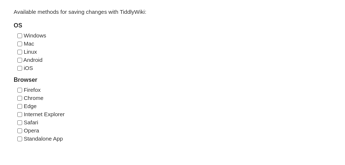Newbie here. I’ve been trying to sort out a straightforward mechanism for keeping my TW up-to-date on 3 devices.
Problem statement:
I have three devices, 2 Windows laptops and an Android phone. I’d like to keep a single Wiki synchronized across these three devices. For me, an ideal solution includes some sort of autosave feature. I don’t want to end up losing tiddlers because I forgot to click “save changes” on one device after which I edit different tiddlers on another device and click save.
Approaches considered:
My first thought was that I could use Tiddlyhost. A minor downside is that it requires network access at all times, but I’d be willing to live with this. More significant to me is that I see no good autosave solution. Tiddlyhost intentionally unsets the autosave flag as described here.
I also considered Tiddlydesktop, which has an autosave feature. Unfortunately, it’s not available for Android.
Yet another possibility could be use of something like Dropbox or Onedrive, though I’m not sure how to set that up. (Or perhaps one of the other Savers in conjunction with local Windows and Android platforms?)
As an experiment, I tried Google Drive. I copied a small TW to GD and could see it on both desktops. Then I edited a tiddler in one and saved it as well as the entire Wiki via ‘save changes’. I then went to the other desktop and refreshed the tab, but I didn’t see the changes. What I noticed is that clicking the ‘save changes’ button causes a new file to be download locally rather than saving. Perhaps I need some other Saver, but I don’t see one for Dropbox. Use of TiddlyDrive Chrome extension might help, but I gather it’s not available for Android Chrome.
Still another possibility I can imagine is to use Tiddlyhost with some way to automatically reset the autosave flag every time I revisit it. This might be the simplest but would subvert Tiddlyhost’s legitimate concern.
I did look at this topic, but I didn’t see anything that addressed my situation.
